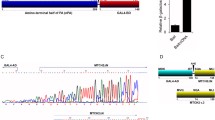Abstract
Objectives
To analyze the function of Ac34 in Autographa californica multiple nuclear polyhedrosis virus (AcMNPV) and elucidate the JNK apoptotic signaling pathway activation in host Spodoptera frugiperda 9 (Sf9) cells induced by the recombinant virus AcMNPV-Ac34-EGFP.
Results
AcMNPV is an important species of baculoviruses. First, viral propagation assay indicated that overexpression of Ac34 protein promoted replication of AcMNPV. Quantitative RT-PCR analysis showed that Ac34 increased the transcriptional level of late genes 38k and vp39, which suggested that Ac34 promoted the production of progeny virus by upregulating transcription of late genes. Second, AcMNPV-Ac34-EGFP inhibited the proliferation of Sf9 cells. Moreover, Sf9 cells infected with AcMNPV-Ac34-EGFP resulted in abundant expression of SfP53 and its accumulation in the nucleus. c-Jun N-terminal kinase (JNK) activation requires MKK4 and MKK7 mediated phosphorylation at Thr183 and Tyr185. We found increased levels of p-JNK1/2 in Sf9 cells infected by AcMNPV-Ac34-EGFP, with concomitant induction of Sf9 cell death. Furthermore, treatment of infected Sf9 cells with SP600125 (an inhibitor of JNK pathway) downregulated p-JNK1/2 and influenced the expression of virus-induced apoptosis protein SfP53, as well as Cytochrome C and Bax.
Conclusion
AcMNPV-Ac34-EGFP virus upregulated the progeny virus production and triggered apoptosis via activation of the JNK pathway in Sf9 cells. In this work, we unveiled an effective virus replication factor-Ac34 and more importantly, developed a recombinant virus that can be used as an improved version of biopesticide.









Similar content being viewed by others
References
Cai Y, Long Z, Qiu J, Yuan M, Li G, Yang K (2012) An ac34 deletion mutant of Autographa californica nucleopolyhedrovirus exhibits delayed late gene expression and a lack of virulence in vivo. J Virol 86:10432–10443
Chejanovsky N, Gershbueg E (1995) The wild-type Autagrapha californica nuclear polyhedrosis virus induces apoptosis of Spodoptera littoralis cells. J Virol 209:519–525
Clem RJ, Fechheimer M, Killer LK (1991) Prevention of apoptosis by a baculovirus gene during infection of insect cells. Science 254:1388–1390
Davy C, Doorbar J (2007) G2/M cell cycle arrest in the life cycle of viruses. Virology 368:219–226
Fu YJ, Zhao J, Liang AH, Hu FY (2015) AcMNPV-mediated expression of BmK IT promotes the apoptosis of Sf9 cells and replication of AcMNPV. Acta Physiologica Sinica 67:305–311
Fu YJ, Wang RS, Liang AH (2018) Function analysis of Ac-PCNA and Sf- PCNA during the Autographa californica multiple nucleopolyhedrovirus infection process. Mol Cell Biochem 443:57–68
Goley ED, Ohkawa T, Mancuso J, Woodruff JB, D’Alessio JA, Cande WZ, Volkman LE, Welch MD (2006) Dynamic nuclear actin assembly by Arp2/3 complex and a baculovirus WASP-Like protein. Science 314:464–467
Marek M, Merten OW, Galibert L, Vlak JM, van Oers MM (2011) Baculovirus VP80 protein and the F-actin cytoskeleton interact connecting the viral replication factory with the nuclear periphery. J Virol 85:535–5362
Matsuyama A, Arai R, Yashiroda Y, Shirai A, Kamata A, Sekido S, Kobayashi Y, Hashimoto A, Hamamoto M, Hiraoka Y, Horinouchi S, Yoshida M (2006) ORFeome cloning and global analysis of protein localization in the fission yeast Schizosaccharomyces pombe. Nat Biotechnol 24:841–847
Mohammad M, Mazhar H, Leila M, Sassan A (2015) The baculovirus anti-apoptotic p35 protein functions as an inhibitor of the host RNA interference antiviral response. J Virol 89:8182–8192
Mu J, Zhang Y, Hu Y, Hu X, Zhou Y, Chen X, Wang Y (2016a) The role of viral protein Ac34 in nuclear relocation of subunits of the actin-related protein 2/3 complex. Virologica Sinica 31:480–489
Mu J, Zhang Y, Hu Y, Hu X, Zhou Y, Zhao H, Pei R, Wu C, Chen J, Zhao H, Yang K, Oers MM, Chen X, Wang Y (2016b) Autographa californica multiple nucleopolyhedrovirus Ac34 protein retains cellular actin-related protein 2/3 complex in the nucleus by subversion of CRM1-dependent nuclear export. PLoS Pathog 12:e1005994
Ohkawa T, Volkman LE, Welch MD (2010) Actin-based motility drives baculovirus transit to the nucleus and cell surface. J Cell Biol 190:187–195
Peng K, Wu MZ, Deng F, Song JJ, Dong CS, Wang HL, Hu ZH (2010) Identification of protein-protein interactions of the occlusion-derived virus-associated proteins of Helicoverpa armigera nucleopoly-hedrovirus. J Gen Virol 91:659–670
Possee RD, Sun TP, Howard SC, Ayres MD, Hill-Perkins M, Gearing KL (1991) Nucleotide sequence of the Autographa californica nuclear polyhedrosis 9.4 kbp EcoRI-I and -R (polyhedrin gene) region. Virology 185:229–241
Qiu J, Tang Z, Yuan M, Wu W, Yang K (2017) The 91-205 amino acid region of AcMNPV ORF34 (Ac34), which comprises a potential C3H zinc finger, is required for its nuclear localization and optimal virus multiplication. Virus Res 15:79–89
Rohrmann GF (2011) Baculovirus molecular biology. National Library of Medicine, National Center for Biotechology Information, Bethesda
Wu C, Wang S (2012) A pH-sensitive heparin-binding sequence from Baculovirus gp64 protein is important for binding to mammalian cells but not to Sf9 insect cells. J Virol 86:484–491
Zhang P, Yang K, Dai X, Pang Y, Su D (2001) Infection of wild-type Autagrapha californica multicapsid nucleopolyhedrovirus induces in vivo apoptosis of Spodoptera litura larvae. J Gen Virol 83:3003–3011
Acknowledgements
This project was supported by Grants from National Natural Science Foundation of China (No.31272100) and Shanxi “1331 Project” Collaborative Innovation Center, 1331 CIC.
Author information
Authors and Affiliations
Corresponding author
Rights and permissions
About this article
Cite this article
Zhang, B., Liang, A. & Fu, Y. Ac34 protein of AcMNPV promoted progeny virus production and induced the apoptosis in host Sf9 cells. Biotechnol Lett 41, 147–158 (2019). https://doi.org/10.1007/s10529-018-2623-3
Received:
Accepted:
Published:
Issue Date:
DOI: https://doi.org/10.1007/s10529-018-2623-3




